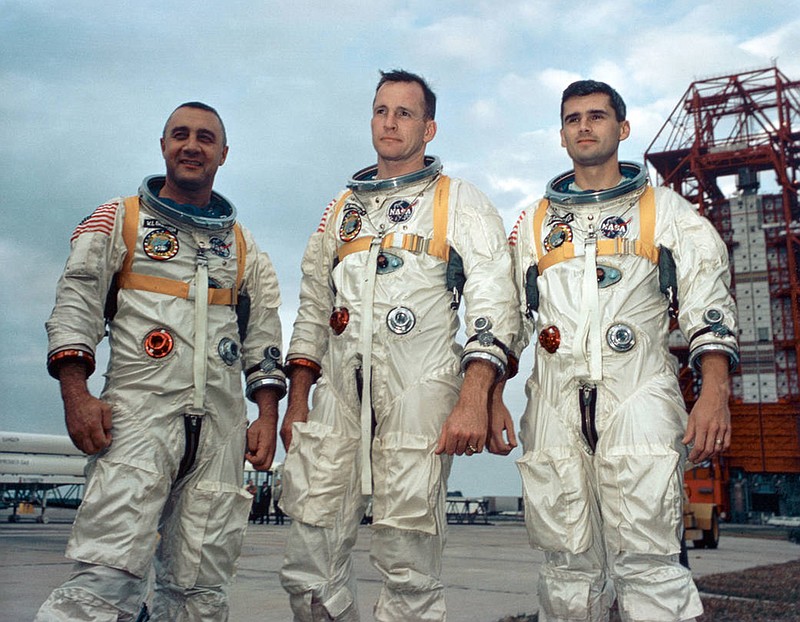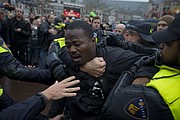ORLANDO, Fla.-When Apollo 11's Neil Armstrong took his one giant leap on the moon nearly 50 years ago, it was a series of small steps that got him there.
Four of the most important ones came from the crewed Apollo missions that immediately preceded the moon landing-Apollo 7, 8, 9 and 10.
Each one helped clear obstacles that stood between America and the moon. Each one provided valuable information so that Armstrong, Buzz Aldrin and Michael Collins would have a successful moon mission culminating with the first human foot steps on the lunar surface on July 20, 1969.
Here's a look at each of the four early crewed Apollo missions and how they set up Apollo 11 for success.
Apollo 7
On Oct. 11, 1968, astronauts Wally Schirra, Donn Eisele and Walt Cunningham became the first humans to go into space aboard the massive Saturn V rocket, designed specifically to get America to the moon.
Ten minutes after their 11:02 a.m. launch from Kennedy Space Center, the Apollo 7 astronauts were in Earth orbit-and would remain there for nearly 11 days. Their mission would be longer than it would it take to get to the moon and back, which was one of the primary mission objectives: to make sure the command module and other parts of the Saturn V would function properly for the duration of a mission to the moon.
With a few minor exceptions, the mechanics and the technology worked fine. It was the humans who had problems.
Less than a day into the flight, Schirra fell ill with a bad cold. Cunningham and Eisele caught it, too.
"A cold is uncomfortable enough on the ground, but in weightlessness it presents a different problem," NASA explained. "Mucus accumulates, fills the nasal passages and does not drain from the head. The only relief is to blow hard, which is painful to the ear drums."
In addition to being sick, Schirra wasn't happy.
"I was bored to tears up there for 11 days," Schirra said in 1998 interview with NBC's Roy Neal. "I mean, bored! Do you remember those little bands you'd wear around your wristwatch for the calendar? I have that band in a plastic block with 8 of the 11 days scratched off, like a prisoner."
Apollo 7 also featured the first live television broadcast from space. "Oddly enough, we got an Emmy for that 'Wally, Walt, and Donn Show,' so I can't really say it was a bad deal," Schirra said.
Schirra's TV work wasn't done, though.
He would capitalize on his Apollo 7 illness by doing commercials for Actifed cold medicine. And he would be sitting next to CBS' Walter Cronkite for the Apollo 11 moon landing in what the network billed as its "Walter to Walter Coverage."
Apollo 8
This mission was supposed to take the lunar module into space for the first time. But there was just one problem-it wasn't ready. So, what would NASA do with Apollo 8?
"Take it around the moon. An enormously bold decision," said Armstrong, who was the mission's backup commander.
Two hours and 50 minutes after being launched from KSC on Dec. 21, 1968, Apollo 8 astronauts Frank Borman, Jim Lovell and William Anders became the first humans to leave Earth orbit and head to the moon. At 68 hours, 58 minutes and 45 seconds into their mission, they also became the first to see the back of the moon and later the first to witness what would become an iconic image of the space program.
In the middle of looking at craters on the moon, Anders happened to see something else that caught his attention.
"Oh my God, look at that picture over there! There's the Earth comin' up. Wow, is that pretty!" he told his crew mates.
He quickly called out for a roll of color film to take a picture of what would be known as "Earthrise"-our planet appearing in space over the moon.
The Apollo 8 astronauts would make six live television broadcasts from space, including a memorable one on Christmas Eve when the crew read from the Bible's book of Genesis and told viewers, "Good night, good luck, a Merry Christmas and God bless all of you-all of you on the good Earth."
In a 2011 interview with Australian television's Alex Malley, Armstrong explained the significance of Apollo 8's flight.
"(It) moved our program along a lot further because we proved we could navigate to the moon, that we could communicate at lunar distance and that the crew could take pictures of the potential landing sites and see what might be a good plan for future flights."
Apollo 9
Astronauts James McDivitt, Russell Schweickart and David Scott never left Earth orbit during a 10-day mission for Apollo 9 that started on March 3, 1969.
They spent the bulk of their mission checking out systems aboard the command module and the lunar module, which was making its first trip into space (finally!).
"Apollo 9 was an engineering mission from beginning to end. We tested every possible thing that could be tested," Schweickart said in a 1999 NASA oral history interview.
The mission is also notable for another reason: It was the first time in the Apollo program that the astronauts decided to name their spacecraft.
"We're Apollo 9. But now we've got two spacecraft, so when we're separated, what are we?" Schweickart explained. "And talking to each other, are we Apollo 9 Alpha and Apollo 9 Bravo, or whatever? We needed to have call signs so that there wasn't going to be any ambiguity, you know. We wanted clear and distinct names."
The crew decided the command module would be known as Gumdrop, because the astronauts said it looked like a gumdrop on the factory floor when it had a thin, blue coating on it. The lunar module would be known as Spider, because "what else does it look like but a spider?" Schweickart said.
"So, Gumdrop and Spider, you know. We didn't ask anybody. We didn't tell anybody. We just started doing it, and it stuck. And from then on in Apollo, the names came back in. So that's the story of naming spacecraft."
Apollo 10
On May 18, 1969, the Apollo 10 astronauts blasted off, flew from the Earth to the moon, and took the lunar lander to the Sea of Tranquility. Thomas Stafford, Gene Cernan and Orlando's John Young did everything that the crew of Apollo 11 would do two months later with one big exception: They didn't land on the moon.
Apollo 10 was the dress rehearsal for Apollo 11. If everything worked properly on Apollo 10, then Armstrong, Aldrin and Collins would be given the first moon-landing mission.
But with Stafford and Cernan in the lunar module flying low over the lunar surface, why didn't they just go ahead and land on the moon?
"My lunar module was too heavy to land," Stafford explained in a 1997 NASA interview.
"I had a heavy weight lunar module, number one, and number two, they also didn't have the software all worked out for that power descent. So, there's no way I could have done it."
Despite not being the first ones to land on the moon, the Apollo 10 crew did achieve a number of firsts in space.
They had the first color TV telecast from space. "We had more prime time on Apollo 10 than we did on (Apollo) 11 or any of the others," Stafford said.
And with Stafford and Cernan off in the lunar module, Young became the first man to orbit the moon alone.
He also had no qualms about not being the first or second person to set foot on the moon.
"I'm glad Neil and Buzz got to do it first," Young said in a 1999 interview with the Jackson (Miss.) Clarion-Ledger. "For one thing, people would've tried to make a big wheel out of me."
Instead, Armstrong, Aldrin and Collins would become the big stars for their historic Apollo 11 flight, but they would also be grounded from any future space flights. But Young had the last laugh.
He would become the ninth person to walk on the moon as commander of Apollo 16, and the first person to command a space shuttle when he flew aboard Columbia in 1981-taking a different kind of leap in history.


